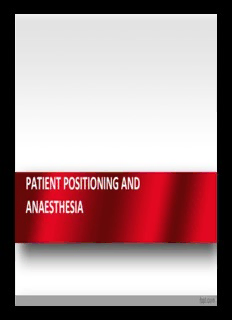
patient positioning and anaesthesia PDF
Preview patient positioning and anaesthesia
PATIENT POSITIONING AND ANAESTHESIA INTRODUCTION • Positioning is the joint responsibility of the surgeon & anesthesiologist. • Ideal pt. positioning involves balancing surgical comfort, against the risks related to the pt. position. • Pt. positioning & postural limitation should be considered during the PAC. Overview • One must be aware of the anatomic and physiologic changes associated with anesthesia, patient positioning, and the procedure. • The following criteria should be met to prevent injury from pressure, obstruction, or stretching: – No interference with respiration – No interference with circulation – No pressure on peripheral nerves – Minimal skin pressure – Accessibility to operative site – Accessibility for anesthetic administration – No undue musculoskeletal discomfort – Maintenance of individual requirements Assessment • The team should assess the following prior to positioning of the patient: – Procedure length – Surgeon’s preference of position – Required position for procedure – Anesthesia to be administered – Patient’s risk factors • age, weight, skin condition, mobility/limitations, pre‐ existing conditions, airway etc. – Patient’s privacy and medical needs GENERAL PHYSIOLOGICAL CONCERNS • CVS CONCERNS In an awake patient postural changes doesn’t cause change in SBP In anaesthesitised patient: PEEP LOW COMPLIANCE CONDITION – OBESITY , GA/RA PPV, MS RELAXATION VR , PRELOAD , ARTERIAL TONE , AUTOREGULATORY MECHANSIM ANTICIPATE AND TREAT THESE EFFECTS , ASSESS THE POSITIONAL CHANGES • PULMONARY CONCERNS • Any position which limits movements of abdomen , chest wall or diaphragm increase atelectasis and intrapulmonary shunt • Change from standing to supine ‐ decrease FRC due to cephalad displacement of the diaphragm Surgical Positions • Variations include: • Four basic surgical positions include: – Trendelenburg – Supine – Reverse trendelenburg – Lateral – Fowler’s/semifowler – Prone – Beach chair position – Lithotomy – Wattson jone position – Position for robotic surgeries Supine • Most common with the least amount of harm • Placed on back with legs extended and uncrossed at the ankles • Arms either on arm boards abducted <90* with palms up or tucked (not touching metal or constricted) • Spinal column should be in alignment with legs parallel to the OR bed – Head in line with the spine and the face is upward – Hips are parallel to the spine • Padding is placed under the head, arms, and heels with a pillow placed under the knees • Safety belt placed 2” above the knees while not impeding circulation ARM TUCKING IN SUPINE POSITION TO PREVENT BRACHIAL PLEXUS INJURY
Description: